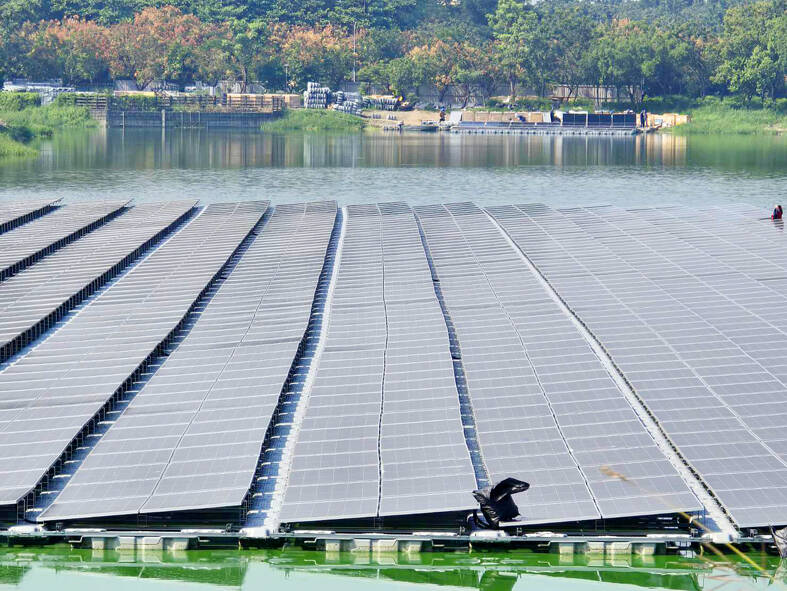The legislature yesterday passed a suite of amendments that would require more stringent environmental impact assessments (EIA) to build solar facilities, as environmental groups and the photovoltaic industry warned against overcorrection.
The Taiwan People’s Party (TPP) yesterday said it aimed to elevate the legal status of solar panel EIA statutes through amendments, after regulations used by the Ministry of Environment failed to block environmentally harmful construction projects, such as the one covering 51 hectares along a hillside in Kaohsiung’s Dashu District (大樹).
The bills seek to tighten solar facility regulations by amending Article 5 of the Environmental Impact Assessment Act (環境影響評估法), Article 11 of the Act for the Development of Tourism (發展觀光條例) and Article 5 of the Geology Act (地質法).

Photo: Yeh Yung-chien, Taipei Times
The solar energy industry yesterday in a statement called for sufficient communication, instead of rushing legislation, to ensure that green energy developments would not be hindered.
Environmental groups called for delaying the legislation, saying the application scope of proposed solar panel EIA criteria requires more nuanced discussions.
Proposed amendments to Article 5 of the Environmental Impact Assessment Act state that EIA must be conducted for proposed solar panel projects on hillsides or floating solar panel projects if the projects have an installed capacity of 10,000 kilowatts (KW) or more, or a cumulative area of 5 hectares or more.
An EIA is required for proposed solar panel projects with an installed capacity of 40 megawatts or more, or with a cumulative area of 40 hectares or more, excluding rooftop solar panels, the amendment states.
The proposed amendment to the Act for the Development of Tourism states that ground-mounted and floating solar panels cannot be installed in national scenic areas, unless they occupy less than 1 hectare and have passed an EIA.
The proposed amendment to the Geology Act states that ground-mounted and floating solar panels cannot be installed in geologically sensitive areas, unless they occupy less than 1 hectare and have passed an EIA.
Citing another bill proposed by Chinese Nationalist Party (KMT) Legislator Alicia Wang (王育敏) in November last year, Democratic Progressive Party (DPP) Legislator Chung Chia-pin (鍾佳濱) said revising the Environmental Impact Assessment Act to stipulate that the five major types of floating solar panel projects — wetlands, ponds, fish farms, flood detention basins and reservoirs — must undergo an EIA would be more appropriate.
Chung criticized the TPP bill for being an improper mix, saying development behaviors and EIA issues should not be dealt with through the Act for the Development of Tourism — which governs recreational behaviors — and the Geology Act, which governs geological assessments.
Such legislation is “keyword index legislation” that might have many holes, Chung said.
Wang said solar panel EIA issues should be regulated at a higher legal status, as the ministry “could not properly handle the issues at all,” adding that the DPP should “move with the times” and support the TPP’s proposal.
TPP Chairman Huang Kuo-chang (黃國昌) said the bill was proposed, because “people can no longer trust the DPP government’s supervision of solar facility developments."

The Central Weather Administration (CWA) yesterday said it expected to issue a sea warning for Typhoon Fung-Wong tomorrow, which it said would possibly make landfall near central Taiwan. As of 2am yesterday, Fung-Wong was about 1,760km southeast of Oluanpi (鵝鑾鼻), Taiwan’s southernmost point, moving west-northwest at 26kph. It is forecast to reach Luzon in the northern Philippines by tomorrow, the CWA said. After entering the South China Sea, Typhoon Fung-Wong is likely to turn northward toward Taiwan, CWA forecaster Chang Chun-yao (張峻堯) said, adding that it would likely make landfall near central Taiwan. The CWA expects to issue a land

The Central Weather Administration (CWA) yesterday said it is expected to issue a sea warning for Typhoon Fung-wong this afternoon and a land warning tomorrow. As of 1pm, the storm was about 1,070km southeast of Oluanpi (鵝鑾鼻), Taiwan’s southernmost point, and was moving west-northwest at 28 to 32kph, according to CWA data. The storm had a radius of 250km, with maximum sustained winds of 173kph and gusts reaching 209kph, the CWA added. The storm is forecast to pass near Luzon in the Philippines before entering the South China Sea and potentially turning northward toward Taiwan, the CWA said. CWA forecaster Chang Chun-yao (張峻堯) said

PREPARATION: Ferry lines and flights were canceled ahead of only the second storm to hit the nation in November, while many areas canceled classes and work Authorities yesterday evacuated more than 3,000 people ahead of approaching Tropical Storm Fung-wong, which is expected to make landfall between Kaohsiung and Pingtung County this evening. Fung-wong was yesterday morning downgraded from a typhoon to a tropical storm as it approached the nation’s southwest coast, the Central Weather Administration (CWA) said, as it issued a land alert for the storm. The alert applies to residents in Tainan, Kaohsiung, Pingtung and Taitung counties, and the Hengchun Peninsula (恆春). As of press time last night, Taichung, Tainan, Kaohsiung, and Yilan, Miaoli, Changhua, Yunlin, Pingtung and Penghu counties, as well as Chiayi city and county had

The Central Weather Administration (CWA) yesterday issued a sea alert for Typhoon Fung-wong (鳳凰) as it threatened vessels operating in waters off the Pratas Islands (Dongsha Islands, 東沙群島), the Bashi Channel and south of the Taiwan Strait. A land alert is expected to be announced some time between late last night and early this morning, the CWA said. As of press time last night, Taoyuan, as well as Yilan, Hualien and Penghu counties had declared today a typhoon day, canceling work and classes. Except for a few select districts in Taipei and New Taipei City, all other areas and city